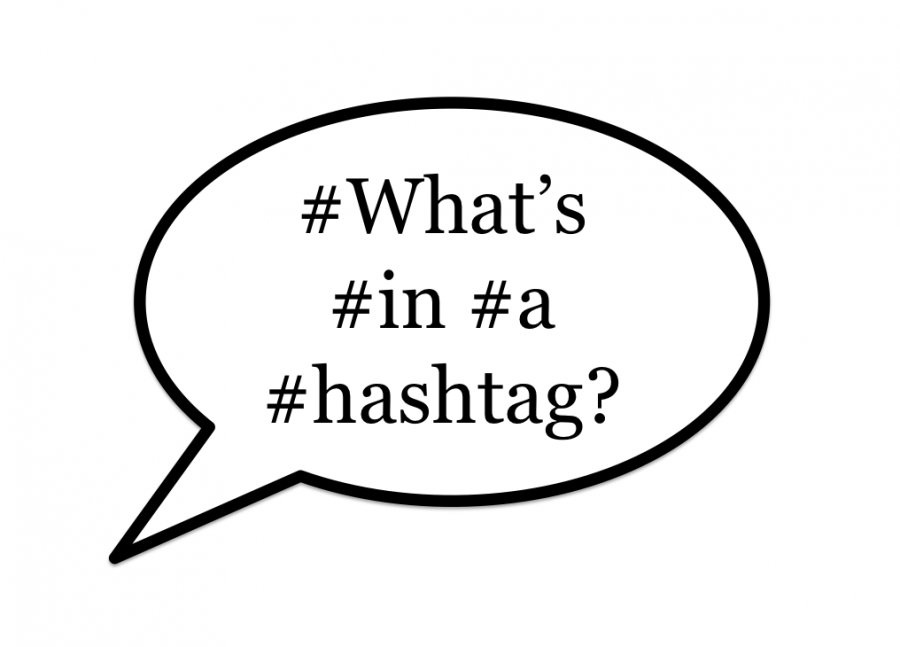BY CAMI ARBOLES
#. It’s that famous symbol you’ve seen practically your whole life. Once popularly known as the “pound” symbol, it was derived from an abbreviation for pounds avoirdupois, a system of weights in which one pound equals 16 ounces. Even before Twitter, this symbol was no recluse. It’s on keyboards and cell phones. It’s the framework for the good, old-fashioned game of tic-tac-toe. It’s the universal symbol for “number,” as seen on every #2 pencil you’ve ever used to take the SAT or aimlessly doodle. Musicians might recognize it as the sharp symbol that raises a note by a half tone, while orthopedic doctors use it as a shorthand way to indicate bone fractures.
Now, though, the pound sign — re-baptized as the hashtag — has become the most socially significant symbol of its time and the key to the powerful world of social media.
“There’s so many different ways to look at the hashtag,” said junior Faith Doney. “You’ve gotta really think about what how it works and what you’re gonna use it for.”
A hashtag is a virtual marker of sorts – place the “#” before any word, phrase, or statement, and it automatically becomes “tagged.” Let’s say one day, you visit The Americana with your best friends and decide to stop by Sprinkles Cupcakes, where obligatory Instagram posts ensue. You add the necessary hashtag, and now, your #sprinklescupcakes photograph joins the 60,000 other Instagram postings that include the same hashtag. It’s an accessible and automatic networking tool.
“When I did a Color Run a few weeks ago, there was a special hashtag you could put with your pictures, so everyone’s pictures that were tagged could go to the same place,” said Doney. “It’s just a nice grouping mechanism that could be useful in some ways.”
Freshman Victoria Ashkinos also recognizes the worthiness of the hashtag as a networking tool.
“For social events, a hashtag is cool,” said Ashkinos. “Like if you’re at a volleyball game at USC, you can hashtag your pictures from the game and get your picture projected on a huge screen at the GALEN center.”
However, some argue that the hashtag often goes too far – it oversteps its boundaries as an organizational networking tool, and traverses into the land of social media excess.
“Taking hashtags too far can be a problem,” said Doney. “It gets too extreme, and then you’re using it for the wrong purpose.”
It’s true – hashtags do have their uncultured side. Social media users often adorn their posts with hashtags for the sole purpose of gathering “likes” and immediate attention from other users. “Sometimes you see a lot of #yolo or #swag or #tagsforlikes,” says sophomore Mary Catherine Smith. “But when people do that all the time, it can get so annoying.”
Junior Victoria Paz also recognizes the shortcomings of hashtags in everyday speech.
“I think it ruins the power of what you’re saying,” said Paz. “Using a hashtag in everyday conversation just doesn’t sound eloquent.”
Furthermore, hashtags are another means for companies to gather information on social media users in order to tailor their advertising to potential consumers.
However, hashtags can also promote significant social causes – consider the ALS Ice Bucket Challenge that pervaded newsfeeds in summer 2014, the powerful #blacklivesmatter that gained speed amidst the Ferguson uprisings in recent months, and even #yesallwomen that arose in the face of recent misogynist and violent acts against women.
But no matter what their use, hashtags are fleeting. They are ubiquitous one day, only to be overshadowed by another viral monster the next.
“I just think that it’s a cool trend,” said junior Claire Stanley. “If you want to use them, then go ahead. Just remember there are other ways to get information out into this world.”


